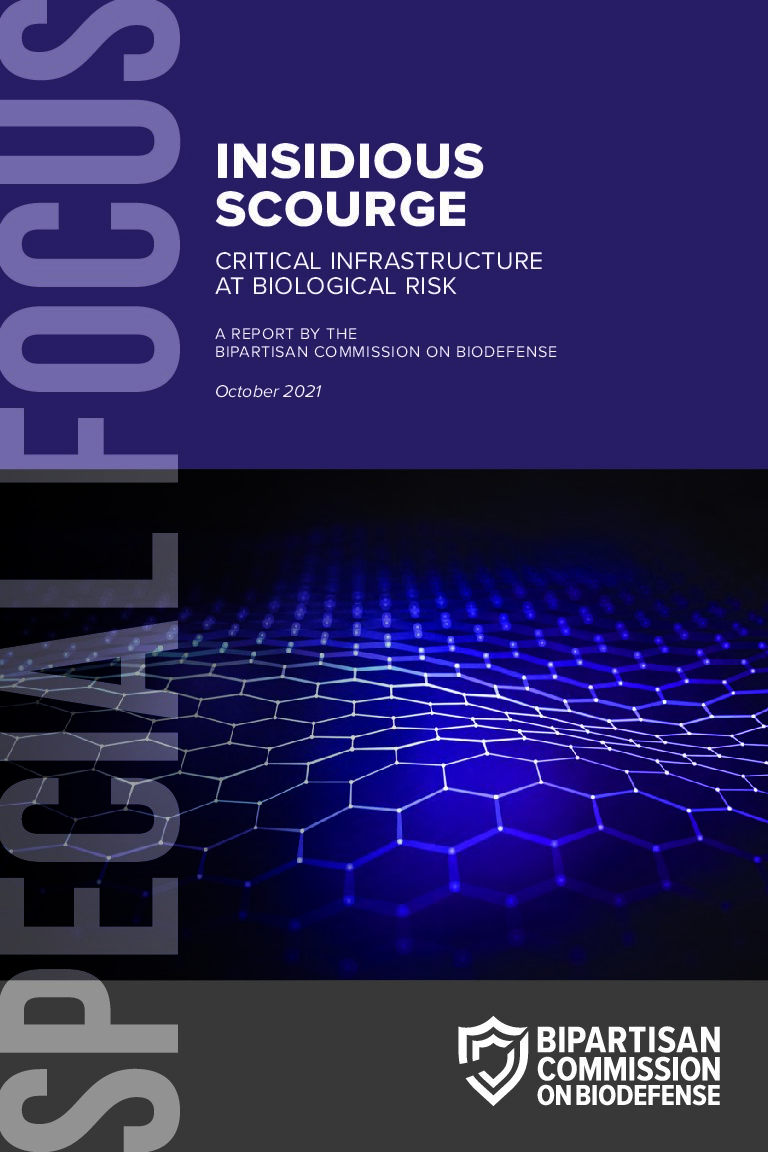- EXECUTIVE SUMMARY
- CASE STUDY: IMPACT OF ANTHRAX 2001 ON CRITICAL INFRASTRUCTURE
- CRITICAL INFRASTRUCTURE AND FUNCTIONS AT BIOLOGICAL RISK
- BIODEFENSE OF CRITICAL INFRASTRUCTURE
- APPENDIX: RECOMMENDATIONS BY SECTOR
- CHEMICAL SECTOR
- COMMERCIAL FACILITIES SECTOR
- COMMUNICATIONS SECTOR
- CRITICAL MANUFACTURING SECTOR
- DAMS SECTOR
- DEFENSE INDUSTRIAL BASE SECTOR
- EMERGENCY SERVICES SECTOR
- ENERGY SECTOR
- FINANCIAL SERVICES SECTOR
- FOOD AND AGRICULTURE SECTOR
- GOVERNMENT FACILITIES SECTOR
- HEALTHCARE AND PUBLIC HEALTH SECTOR
- INFORMATION TECHNOLOGY SECTOR
- NUCLEAR REACTORS, MATERIALS, AND WASTE SECTOR
- TRANSPORTATION SYSTEMS SECTOR
- WATER AND WASTEWATER SECTOR
- ACRONYMS
- ENDNOTES
Commissioners
Joseph I. Lieberman, Chair
Thomas J. Ridge, Chair
Donna E. Shalala
Thomas A. Daschle
James C. Greenwood
Kenneth L. Wainstein
Ex Officio Members
Yonah Alexander, PhD
William B. Karesh, DVM
Rachel Levinson, MA
Lewis Libby, JD
Gerald W. Parker, DVM, PhD
George Poste, DVM, PhD, DSc
Tevi Troy, PhD
Commission Staff
Asha M. George, DrPH, Executive Director
John T. O’Brien, MS, Research Associate
Robert H. Bradley, Policy Associate
Patricia de la Sota, Operations Manager
Acknowledgments
The Commission appreciates the willingness of critical infrastructure owners and operators to share their biodefense concerns and priorities with us. We greatly appreciate the perspectives of Henrik Birk, Bavarian Nordic; Jason Blumenauer, Cardinal Health, Inc.; Joe Coomer, AMB Sports and Entertainment; Dr. Malick Diaria, ExxonMobile Corporation; Terrell Harris, FedEx Corporation; Sara Roszak, National Association of Chain Drug Stores; and David Stoltzfus, Monsanto. We thank Ann Beauchesne and Jennifer Stone, President, Partner Forces, for their insights regarding critical infrastructure risk management. We thank our ex officio members for their advice and input. The Commission also gratefully acknowledges the financial support provided by our donors, and Hudson Institute, which serves as our fiscal sponsor.
Executive Summary
Critical infrastructure and national critical functions are threatened by, vulnerable to, and experience the consequences of biological attacks, accidents, and naturally occurring diseases—in other words, they are at biological risk. Biological events could destroy, incapacitate, and disrupt critical infrastructure and prevent our society from both functioning properly and protecting itself. Illness and death, physical compromise of sectors, data theft and compromise, just-in-time inventories, mass gatherings, unprotected transit and other distribution systems, and poor awareness of where and how diseases spread are all of concern. When biological events overwhelm critical infrastructure, effects on society cascade, further weakening our country.
Copyright © 2021 by the Bipartisan Commission on Biodefense. All rights reserved.
www.biodefensecommission.org
Graphics and design by Factor3 Digital.
Base cover image courtesy of Shutterstock.com.
Suggested Citation
Bipartisan Commission on Biodefense. (2021). Insidious Scourge: Critical Infrastructure
at Biological Risk. Bipartisan Commission on Biodefense: Washington, DC.


